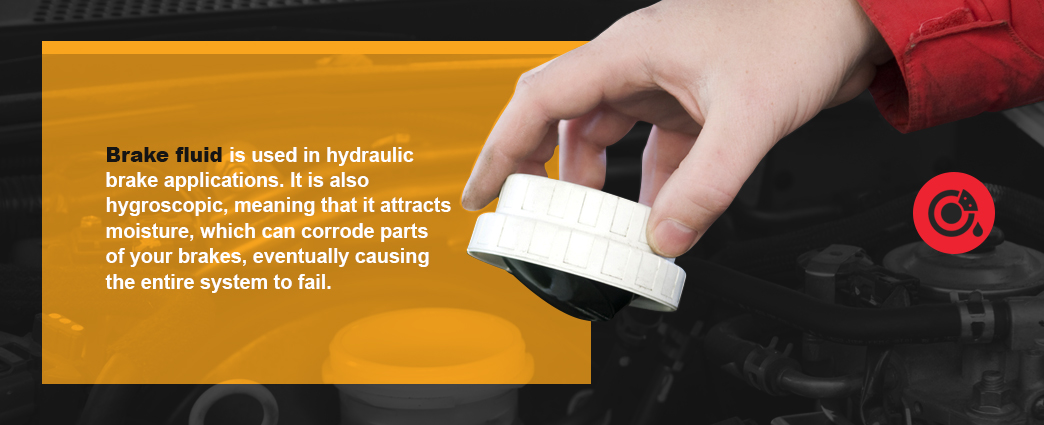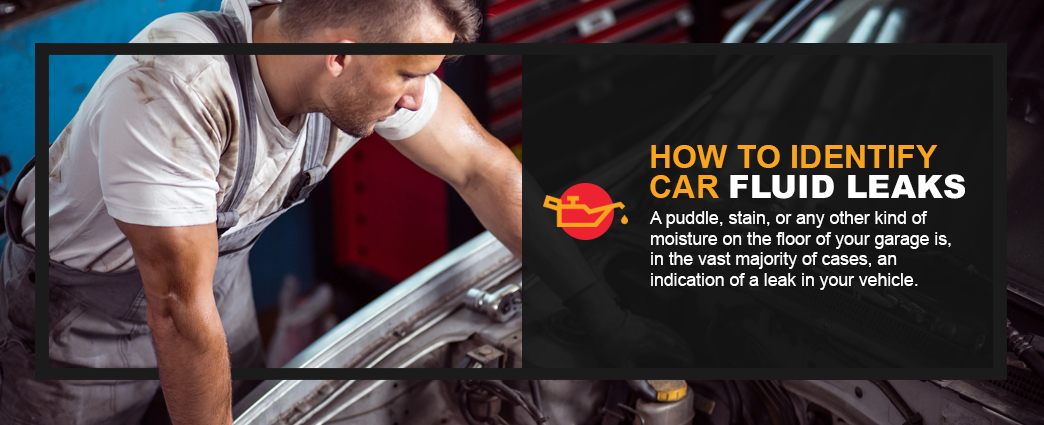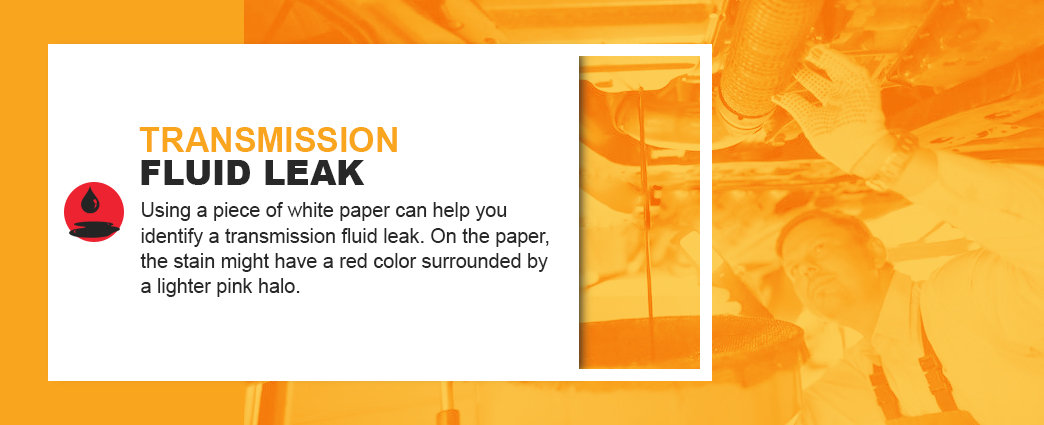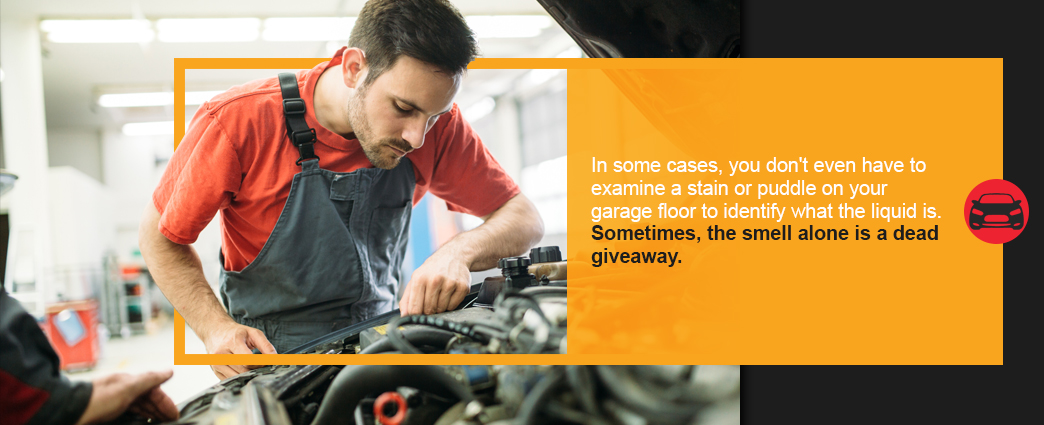A leak is often the first indication of problems under your hood. If it’s not taken seriously, it can lead to serious consequences, ranging from braking and steering issues to total engine failure. If you own a car, you’ll likely encounter a leak at some point, so it’s important to be able to identify what is leaking from your car and why.
To help you identify the fluid leaking from your vehicle, we’ve put together a guide on how to pinpoint the source of leaks coming from under your hood.

Common Car Fluid Leaks
Below is a brief overview of the most common fluids known to leak in cars:
Engine Oil
Think of engine oil as your car’s blood — it moves through your engine, keeping it clean and lubricating all parts to minimize wear and friction. Engine oil consists of two primary components: base stock and additives. The base stock generally makes up about 95 percent of the formula and is made either from synthetic chemicals, petroleum or a mix of both. The base stock finely controls oil lubricity and viscosity and keeps the engine’s parts from wearing down. Zinc dialkyl dithiophosphate is a commonly used additive to prevent wear. Magnesium sulfonates are used to help break down impurities and engine sludge.

You should check the engine oil about once a week when your car is still warm and sitting on level ground. Before checking your oil, turn off your engine and wait several minutes to allow the oil to settle, then take out the dipstick and wipe it clean. Then, push the dipstick back in all the way, wait a moment, then take it out and inspect the level again. The engine oil should be between the two marks.
Transmission Fluid
Transmission fluid lubricates and protects the complex gears of your car’s transmission. It also contains detergents that help trap contaminants that can be potentially destructive. Your car needs the right transmission fluid type the transmission to continue to function properly. It’s also vital that your car has the recommended level of transmission fluid at all times. Signs that it’s time to change your transmission fluid include a decline in gas mileage, missing gears and inconsistently engine revving.
Consult the owner’s manual for your vehicle to learn how to find the dipstick for the transmission fluid and how to determine the fluid level. Different manufacturers recommend different steps — there may be differences in whether you should check the level when your car’s cold or hot, when it’s in neutral or park and when it’s turned off or running.
The recommended interval for changing your transmission fluid also varies from car to car, and may partly depend on whether you’re using conventional or synthetic transmission fluid. Check your owner’s manual for the change interval that it recommends — it may be as frequently as every 30,000 miles or as rarely as every 100,000. If the transmission fluid smells burned or is dark, either is a sure sign that you need to change it as soon as possible.
Engine Coolant
Also known as antifreeze, engine coolant is mixed together with water to protect the radiator from overheating in extremely high temperatures and freezing in extremely low ones. It is located under the hood of your vehicle, often toward the front and usually has a colored cap. The cap may have the words “engine coolant” printed on it.

We recommend that you check the levels of your engine coolant once a week, if possible. Your coolant system is a sealed unit that constantly circulates coolant, so the levels shouldn’t change too much. If they do change, there may be a leak. Low coolant levels may cause a warning light on your dashboard to illuminate.
Power Steering Fluid
Power steering fluid, along with the power steering pump, makes up your power steering system, which makes it much easier to turn your steering wheel. Once a pricey add-on option, power steering fluid now comes standard on most vehicles. If you’ve ever heard a loud moaning or groaning sound when turning the wheel, there is a good chance that your power steering fluid levels are low.
How to change your power steering fluid — or if you even need to change it at all — depends on your car’s manufacturer. Keeping power steering fluid levels at the right level is crucial if you want to avoid damage to your power steering pump.
Power steering fluid is often in an opaque tank with a gauge that lets you see the level of fluid in the tank. Some vehicles have a cap that you can remove as well as a dipstick with “cold” or “hot” markings indicating where the level should be depending on the temperature of the engine.
Brake Fluid
Brake fluid is used in hydraulic brake applications. It is also hygroscopic, meaning that it attracts moisture, which can corrode parts of your brakes, eventually causing the entire system to fail. The recommended interval for changing brake fluid is based on mileage or time. Using the right brake fluid type in your car is extremely important. Your vehicle’s owner’s manual should tell you when to change the brake fluid and the type of product to use.

To check the levels of your brake fluid, first, locate the reservoir. Its location will depend on the kind of vehicle you have. Your brake booster is located on your vehicle’s driver’s side, typically near the firewall. In front of that is the reservoir for the brake fluid, which will be connected to the brake master cylinder. The reservoir is generally in a see-through plastic canister.
The reservoir tends to be see-through so you can check it quickly without having to remove the cap, which would introduce moisture from the atmosphere into the fluid. You’ll notice that the reservoir has “maximum” and “minimum” markings. The level of the fluid should be somewhere in between the two. If the fluid is dirty and dark brown, change it.
How to Identify Car Fluid Leaks
A puddle, stain, or any other kind of moisture on the floor of your garage is, in the vast majority of cases, an indication of a leak in your vehicle. A fluid leak is often a sign that your car needs attention. Knowing how to identify the most common kinds of fluid leaks will serve you well.

Engine Oil Leak
The first thing you should understand about engine oil leaks is that they don’t typically make a puddle under your vehicle. If you do see a puddle of oil, this is likely a serious problem that a mechanic should check out immediately. As engine oil tends to be more viscous than other vehicle fluids, it will often “seep” or “crawl” through the car engine’s other parts. When enough oil accumulates, it will begin to drip onto a driveway or the floor of your garage.
Engine oil tends to have a light amber or slightly brownish-yellow color. If the oil is older, however, it can be darker, typically a dark brown. If your oil hasn’t been changed in a really long time, it might appear black.
Leaking engine oil can be caused by a number of factors:
- The engine’s gaskets may have started to deteriorate.
- The hoses responsible for circulating the engine oil through the system have poor connections.
- There are leaks in the oil pan.
- The oil seals are degraded.
- The oil filter is incorrectly attached.
- The oil plug isn’t secured correctly or isn’t tight enough.
- The oil pressure is excessively high.
Whatever the reason happens to be, it’s important to always have the issue checked out by a professional mechanic.
To differentiate an oil leak from other kinds of fluid leaks in your car, you first need to determine where your transmission and engine are located. They may be up near the front, which is the case for most cars, or in the back. If you’re not sure what the color of the fluid is, place a piece of clean, white paper under your engine and leave it overnight. The next morning, see if there are any oil stains on your paper.
Checking the fluid’s consistency and odor is also a good idea. Oil has a slick, thick feel and can smell gassy.
Transmission Fluid Leak
Diagnosing a leaky transmission is fairly simple. The location of the leak alone should make it obvious, as long as you know where your vehicle’s transmission is located.
The fluid itself is also quite distinct — it’s usually red and leaves a reddish stain. It also has a lower viscosity than engine oil. If you’ve never changed your transmission fluid, the fluid might be a brownish color and more viscous.
Using a piece of white paper can help you identify a transmission fluid leak. On the paper, the stain might have a red color surrounded by a lighter pink halo. New transmission fluid has a lower viscosity, so it tends to seep through the principal stain’s surrounding area. The result is a red dot with a pink corona. This means that your leaking transmission fluid is new.

If the stain has a brownish color, then you won’t see a halo surrounding it, because of the increased viscosity. Keep in mind that an older transmission fluid stain can look much like that of a motor oil leak.
A transmission fluid leak occurs due to degraded or damaged transmission seals. The fluid line, usually made of aluminum or steel, is also known to break or crack with time. The torque pump can also crack, causing leaks in the transmission fluid. There is also a chance that, if work has been done on your transmission system in the past, some components may have not been properly installed.
Engine Coolant Leak
If you notice a greenish-colored puddle on your garage floor underneath your radiator, chances are that it’s engine coolant. We say “greenish-colored” because most antifreeze solutions are green, but if you use antifreeze of another color, such as red, blue or orange, then that is the color that the stain should be. If you’re having trouble determining the color of the stain, smell it and try to identify the odor. Antifreeze generally smells sweet due to the ethylene glycol it contains. It is the sweet smell of antifreeze that also makes it dangerous for dogs and cats, as they will often interpret the sweet smell as something delicious.
You should also be aware that leaking antifreeze doesn’t just create stains under your car’s radiator — the engine cooling system is extensive and runs from the engine all the way to the radiator. It’s also a possibility that a leak will occur between the antifreeze reservoir and the radiator, between the engine and the radiator and between the exhaust pipe and the engine. It’s a good idea to check the fluid’s consistency, which is less thick than oil but thicker than water.
An engine cooling system leak can be caused by a number of factors. Common causes include a damaged radiator or radiator hose. Since the performance of your car greatly depends upon your engine staying at the right temperature, we recommend that you have a mechanic check out any engine coolant-related issues.
Power Steering Fluid Leak
Identifying power steering fluid can be tricky because the leaking fluid’s appearance alone is often not enough to determine it is power steering fluid or not. Many drivers use transmission fluid for their steering pump fluid, so the leak may look a lot like one coming from your transmission. Some car drivers, however, use a dedicated fluid for power steering. If you fall into the latter category, see if the color of your power steering fluid matches the color of your leak.

One way to figure out whether the leak is from your transmission or your power steering is to correlate it with the function of your steering. Power steering fluid serves to ensure you have optimal control of the steering wheel. It makes the wheel much easier to turn, often requiring almost no effort on your part. If you noticed that steering became more difficult or the response became more sluggish around the same time when you found the leak, it is likely that the leak is from your power steering system.
You should also check underneath your vehicle and follow the hoses connecting to your power steering. You can examine the reservoir’s integrity as well as that of your power steering pump. Learn where these parts are located so that you can compare their locations to the location of the stain on the floor or driveway.
Brake Fluid Leak
If you notice a transparent or slightly yellow fluid under your vehicle, there is a good chance you’ve got a brake fluid leak on your hands. If you want to be more certain, you can also check the location of the stain and compare it to the location of your brake pedal, the reservoir for the brake fluid and its hoses. Since the brake system of your car is connected to your wheels, it is possible to find it by your tires, as well.
If you notice a brake fluid leak, it is critical that you have a mechanic take a look right away. Brake fluid is required for operating your brake system’s calipers and, if there’s not enough of it, the calipers could malfunction and the brake pads might not even clamp onto your rotors when the brakes are applied. Technically, even pushing on the brake pedal will be exceedingly difficult.
Brake fluid leaks often occur when damage is done to the hoses that deliver the liquid to other parts of the braking system. You should have a mechanic examine the hoses’ integrity by following the brake lines.
Fuel Leak
In some cases, you don’t even have to examine a stain or puddle on your garage floor to identify what the liquid is. Sometimes, the smell alone is a dead giveaway. If your leak smells like gasoline, then it is definitely gasoline. The important question is: where is the leak coming from?

A gasoline leak tends to have a watery consistency and brownish color. If you found the stain near the rear end of your car, it’s possible that the issue is located in the gas tank. If the stain is closer to the front, this is usually a problem with your fuel pump. There is also a chance that a leak could occur anywhere along the whole length of your fuel system.
Water
Although your car doesn’t necessarily require fluid to properly operate, it is a natural byproduct of some of your car’s processes. One example is your vehicle’s AC system: On a hot, humid summer day, your system will have to work hard to keep you cool and to remove the moisture inside the car. This moisture gets drained to the ground via a hose.
How Much Does it Cost to Get These Leaks Fixed?
In almost all cases, having a mechanic repair your fluid leak will cost you an average of $100 or more. The cost to repair a leak depends on your location, your vehicle and the extent of the problem.

Can You DIY These Fixes?
You sure can! Bar’s Leaks offers products to stop a variety of common leaks in your vehicle, including:
- Liquid Aluminum: This formula not only stops your coolant and heater core leaks, but it also helps to prevent these issues in the future.
- Super Leak Fix: This fast-acting formula stops leaks in the transmission, engine, power steering systems and various other components in your car.
- Transmission Stop Leak Concentrate: This formula stops and seals all leaks in your transmission and works with all automatic and manual transmission fluids.
- Engine Oil Stop Leak Concentrate: This effectively stops and seals all engine oil leaks and works with any kind of engine oil.
- DiFM Professional Cooling System Treatment: These tablets are great to use whenever you’re working on your cooling system, including flush, fills and parts replacement. This seal treatment keeps scale and rust from forming, cleans the system and seals external, internal and coolant-to-oil leaks.
- Radiator Stop Leak Concentrate: This formula stops and seals leaks in your cooling system and works with all colors of antifreeze.
- Power Steering Stop Leak Concentrate: This product stops and seals leaks in your power steering systems. It is compatible with all kinds of steering fluid.
Avoid Expensive Car Repairs by Choosing Bar’s Leaks
If you have questions about how to use our products to stop a fluid leak or want to know more about what you can do to keep leaks from happening in the future, the team at Bar’s Leaks is happy to help you out. Use our store locator to find a Bar’s Leaks store near you.


